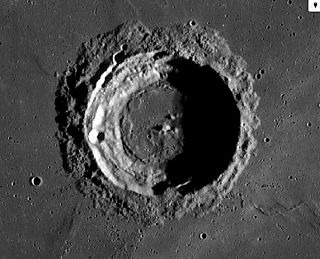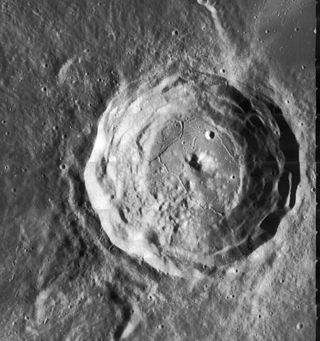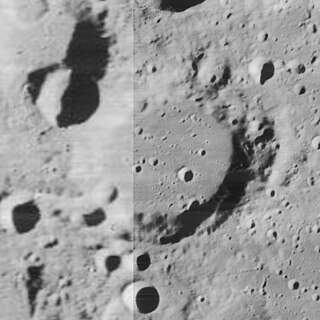
Bayer is a lunar impact crater located in the southwest section of the moon, to the east of the crater Schiller. The rim of Bayer is slightly worn by erosion, but remains well-defined. There is an inner terrace, but the outer wall is intruded upon by nearby impacts. The most significant of these is Schiller H, which forms a ridge attached to the northwest rim of Bayer. The floor of Bayer is relatively flat and lacks a central peak. There is a small, but notable crater on the floor near the western wall. This crater has a breach in its northern rim.

Eddington is the lava-flooded remnant of a lunar impact crater, located on the western part of Oceanus Procellarum. The western rim is attached to the wall of the walled plain Struve. To the east-southeast is the smaller but prominent crater Seleucus. South of Eddington is Krafft.

Seleucus is a lunar impact crater located in the western part of Oceanus Procellarum. To the west is the lava-flooded remains of the walled plain Eddington. To the southwest is the crater Krafft and to the northwest lies Briggs.

Chladni is a small lunar impact crater that lies near the northwest edge of Sinus Medii, in the central part of the Moon. The crater is named for German physicist and musician Ernst Chladni who, in 1794, wrote the first book on meteorites. The rim of the crater is roughly circular, and there is a small central floor at the midpoint of the sloping inner walls. This feature has a higher albedo than the surrounding terrain. It is connected by a low ridge to the rim of the crater Murchison, which lies to the northwest. Due east of Chladni is the larger Triesnecker.

Cardanus is a lunar impact crater that is located in the western part of the Moon, in the western part of the Oceanus Procellarum. Due to its location the crater appears very oval because of foreshortening, and it is viewed almost from the side.

Bianchini is a lunar impact crater that lies along the northern Jura Mountains that ring the Sinus Iridum, in the northwestern part of the near side of the Moon. It was named after Italian astronomer Francesco Bianchini. The impact of this crater near the edge of the Jura Mountains deposited some material into the Sinus Iridum floor.

Atwood is a small earth moon impact crater that is located on the Mare Fecunditatis, to the northwest of the prominent crater Langrenus. It forms a triple-crater formation with Naonobu attached to the north rim and Bilharz near the west rim.

Boss is a lunar impact crater that is located along the northeast rim of the Moon's near side. Due to its location, the crater is viewed from the side by observers on the Earth, and its visibility is subject to libration effects. It was named by the IAU in 1964 for astronomer Lewis Boss.

Behaim is a lunar impact crater that is located near the eastern limb of the Moon, just to the south of the crater Ansgarius. To the south of Behaim is the crater Hecataeus, and to the east-southeast is Gibbs.

Bohr is a lunar impact crater that is located near the western lunar limb, in the area that is affected by librations. It is attached to the southwestern rim of the larger, eroded Vasco da Gama formation, and to the southeast of the crater Einstein. The crater was observed for the first time in 1963, by Arthus and Ewen Whitaker in the book Rectified Lunar Atlas.

Bellinsgauzen is a lunar impact crater that lies in the southern part of Moon, on the far side from the Earth. It is attached to the northern rim of the larger crater Berlage, and within a half crater diameter of Cabannes to the west. North of Bellinsgauzen is the crater Bhabha.

Cook is a lunar impact crater that lies in the western part of the Mare Fecunditatis, just to the southeast of the prominent crater Colombo. To the southwest is Monge.

Cleostratus is a lunar impact crater near the northwest limb of the Moon. It lies to the northeast of the crater Xenophanes, and west-southwest of the prominent Pythagoras. From the Earth this crater appears highly elongated due to foreshortening.

Challis is a lunar impact crater that is located in the northern regions of the Moon's near side, close enough to the limb to appear significantly foreshortened when viewed from the Earth. It is joined to the crater Main through a break in the northern rim, and is close to Scoresby along the southeast side.

Chappell is a lunar impact crater on the far side of the Moon, in the northern hemisphere just to the north of the crater Debye. It is in a heavily bombarded section of the surface, and much of its outer rim is overlain by smaller craters. The northern rim in particular has been almost completely disintegrated, while small craters also overlie the rim to the northwest and southeast. What remains of the rim forms a rounded, somewhat irregular edge to the crater depression.

Chevallier is a lunar impact crater that is located in the northeastern part of the Moon's near side, about a crater diameter east-southeast of the prominent crater Atlas. To the south-southeast of Chevallier is the flooded crater Shuckburgh. Chevallier was named by the IAU in 1935.

Coriolis is a lunar impact crater that is located on the far side of the Moon. The crater floor is bisected by the lunar equator, and it lies about three crater diameters northwest of the crater Daedalus.

Debes is a lunar impact crater that is located to the north of the Mare Crisium, in the eastern part of the Moon's near side. It was named after German cartographer Ernst Debes.

Dalton is a lunar impact crater that is located near the western limb of the Moon's near side. It is attached to the eastern rim of the walled plain Einstein, with Balboa lying just to the north and Vasco da Gama due south. The rim of this crater is not heavily eroded, and the interior walls are terraced. The interior floor has a system of rilles that are generally concentric with the inner wall. There is a small crater near the southern inner wall, and another at the north face of the small central peak.

Fourier is a lunar impact crater that is located in the southwestern part of the Moon's near side, just to the southeast of the crater Vieta. To the northeast is the Mare Humorum. The rim of this crater is roughly circular, but appears oval when viewed from the Earth due to foreshortening.






















